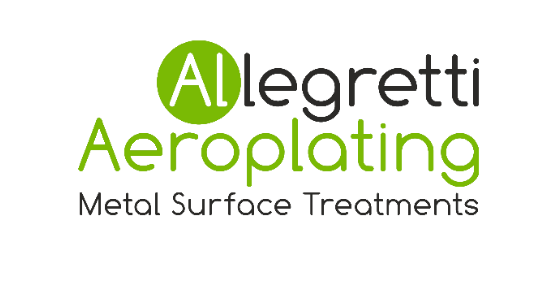REACH
RoHS Conformity
The following treatments are RoHS compliant:
- Sulfuric anodizing, except when sealed with dichromate
- Hard anodizing, except when sealed with dichromate
- Surtec 650V
- Electrolytic nickel-plated zinc
- Stainless steel passivation and stainless steel pickling
- Anodizing and pickling of titanium
- Some paint schemes - contact us for more details
The following treatments are not RoHS compliant or may not be RoHS compliant:
- Sulfuric anodizing sealed with dichromate
- Hard anodizing sealed with dichromate
- Chromic anodizing
- Alodine 1200
- Some paint schemes - contact us for more details
REACH compliance
As part of its surface treatment process, Allegretti Aeroplating Srl uses certain chemicals considered SVHC under the EU REACH directive.
This page attempts to provide information on which processes use SVHC and which treatments contain SVHC in their final form. This article is published for the information of our customers and to fulfill our duties under Article 33 of the Directive.
This information is based on the SVHC list as displayed on the ECHA website on 14/02/2018, refer to the ruling in case C-106/14 at the Court of Justice of the European Union and are based on the ECHA Guidance on requirements for substances in articles (version 3.0, published in December 2015).
Allegretti Aeroplating Srl is unable to determine whether an item is REACH compliant or not.
An engineered component is an item before it reaches us and an item when we have coated it.
The coating itself is not a article, but a transformation process.
Surface treatments are classified as light treatments according to the ECHA guide. However, our coating can impact the REACH status of the item as a whole and this information seeks to inform you to make your determination part by part.
SVHC
SVHCs used in our manufacturing process are limited to chromium (VI) compounds, which we have attempted to list below.
As chemists will understand, chromic acid, chromates and dichromates are in equilibrium each other, so it is impossible to say with certainty what form they take when incorporated into the cladding:
- chromic acid (231-801-5, 236-881-5) and chromium trioxide (231-889-5)
- sodium dichromate (EC 234-190-3)
- Pentazinc chromate octahydroxide (EC 256-418-0)
- strontium chromate (EC 232-142-6)
The following treatments use SVHC in the manufacturing process:
- Chromic anodizing - in the anodizing of the electrolyte
- Sulfuric anodizing sealed with dichromate - in the sealing solution
- Alodine 1200 - in the conversion coating solution
- Stainless steel passivation - in some passivation and post-passivation solutions, SVHC-free alternatives are also available
- Some paint systems, containing chromates.
The following treatments do not use SVHC in the manufacturing process (or is optional):
- Sulfuric/Hard anodizing, except when sealed with dichromate
- Surtec 650V
- Zinc-nickel
- Some paint systems, free of chromates.
- Titanium Anodizing
- Passivation in stainless steel, nitric only
- Stainless steel pickling
- Dry film lubricants.
The following treatments contain or may contain SVHC in the final coat:
- Chromatic anodizing (possibly above threshold)
- Sulfuric/hard anodizing sealed with dichromate (probably above threshold)
- Alodine 1200 (probably above threshold)
- Chrome-based paint systems (probably above sill)
- Galvanizing with hexavalent/colored passivated (possibly above threshold)
Although passivation of stainless steel may utilize SVHC in the manufacturing process, with proper rinsing it is unlikely to be found in the final product.
When the base material is porous (such as some castings) or there is another risk of entrapment, there is a possibility that chromium (VI) compounds are present in the article beyond the coating from the manufacturing process. This can significantly increase the amount of SVHC in the article. However, as the mass of the item is usually much greater than the part as a whole, this alone is likely to bring the percentage below the 0.1% threshold for most of the parts we process. If customers can provide Allegretti Aeroplating Srl with the total mass of the part and its surface area, we can estimate the maximum mass of SVHC provided by our machining.
We believe that no non-exposure argument can be made for SVHCs in our coatings due to mobility of chromates in the presence of moisture.
Closing Dates.
If SVHCs are not cleared prior to the ceasing date (and no applications are still being processed pursuant to transitional arrangements), the substances will cease to be available. Authorization applications have been submitted within our supply chain, but it is not clear at this stage whether they will be successful and what further restrictions might apply to their use. Our advice to customers is that they should work with us to design SVHCs from their parts and manufacturing processes on the assumption that their specific use may not be licensed. we likely won't know more until very close to or even after the quit date, hence our recommendation for this precautionary approach.
Alternative Treatments
For all of our treatments, alternatives are available that do not use SVHC in the manufacturing process and leave no SVHC in the item after processing. These are suitable for a large number of applications and there are very few applications where they are not suitable for technical reasons.



